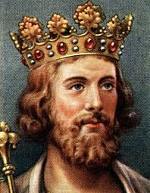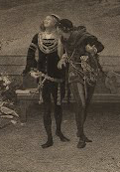King Edward II of England
Part 1: His Father's Shadow England's King Edward II had a troubled reign exacerbated by his own weaknesses. The son of the "Hammer of the Scots," Edward is the English king who lost an epic battle that led to Scottish independence and then was forced to abdicate in favor of his son. He was the first King of England to give up his throne voluntarily. He was born on April 25, 1284 at Caernarfon Castle in Gwynedd, Wales and came to known as Edward of Caernarfon. His father was England's King Edward I, who was in the middle of conquering Wales when young Edward was born and who went on to defeat Scotland and occupy much of that country as well. He had a strong reputation as a ruthless leader, a shrewd battle tactician, and an accomplished statesman, in England and on the Continent. Young Edward's mother was Eleanor of Castile. She and Edward I had 16 children, among them four sons. Their first son, John, lived just five years; and their second son, Henry, lived just six years. A third son, Alphonso, was born in 1273 and was the heir to the throne when young Edward was born. Alphonso died in that same year, however, and the very young Edward was the king's heir almost from birth. Eleanor died when Edward was 5, and he was left to try to follow in his father's giant footsteps. The following year, Edward I negotiated with Scotland to have its intended new ruler, Margaret the Maid of Norway, marry the young Edward. Margaret was the granddaughter of Scotland's King Alexander III, who had died in 1286 without an heir. The marriage of Margaret, who was at the time 3, and Edward, who was at the time 6, was intended to avoid a succession controversy. Margaret died on the journey from Norway, however, and a number of Scottish nobles put themselves forward as Alexander's successor. This period in Scottish history came to be known as the Great Cause. Edward I ultimately chose John Balliol as King of Scotland but then proceeded to act like Scotland's monarch anyway, invading when necessary to prove his point. 
Young Edward was tall and good-looking and stubborn like his father. The two Edwards had a few other things in common, but they were more different than they were alike. Young Edward liked horses and dogs, particularly greyhounds. He enjoyed rowing. He studied religion and military skills. He spoke Norman French and some English and a bit of Latin as well. All of those would have been familiar to his father. Young Edward also liked music, particularly organ music, and was quite fond of spending time with common laborers and other non-nobles. He also had no interest in falconry or hunting. Early in his life, he had members of the nobility questioning him. Edward I was involved in wars with France and Scotland for several years. In 1297 and 1298, Edward was fighting in Flanders and left young Edward in charge in England. When Edward I was 60, he married again, to Margaret, the sister of France's King Philip IV, Margaret of France, who was 17. Young Edward was 15 at the time, and he became fond of his stepmother. The peace treaty that brought about the marriage also stipulated that young Edward would eventually marry Philip's daughter, Isabella. She was 2 when the treaty was signed. Even though Edward I had won the pivotal battle of Falkirk and executed the Scottish rebel patriot William Wallace, Scotland was still a simmering cauldron of discontent. Edward I returned at the head of an army to Scotland in 1300, and young Edward went with him. The young soldier commanded the rearguard during an important castle siege. Father and son took part in subsequent Scottish campaigns in the next few years. Young Edward had some battlefield success, capturing Turnberry Castle and aiding in the siege of Brechin Castle. Edward was in charge of yet another English war expedition into Scotland. In 1306, Robert the Bruce had dispatched John the Black Comyn and declared himself King of the Scots. King Edward put together a large army, but it was young Edward who marched at the head of it. The English retaliation for Bruce's actions was brutal, and Edward returned triumphant. In 1301, the king declared young Edward Prince of Wales (the first English person so named). Four years later, after a dispute between Young Edward and the royal treasurer over money, King Edward banished his son and his friends from the royal court and cut off their financial support. Father and son were reconciled after mediation. 
Just a year before, a young man named Piers Gaveston, a son of one of King Edward's household knights, had joined the household retinue of Prince Edward. Gaveston and the prince became very close. Historians differ as to the specific nature of the relationship between the two men. It is known that King Edward exiled Gaveston to Gascony in 1307. In that year, yet another English army set off for Scotland. Both Edwards were in attendance; however, King Edward was very weak. He insisted on accompanying the army and died on July 7. Prince Edward was declared to be King Edward II on July 20. Next page > King in His Own Right > Page 1 2 |
|
Social Studies for Kids
copyright 2002–2025
David White




